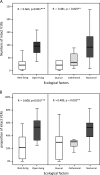More functional V1R genes occur in nest-living and nocturnal terricolous mammals
- PMID: 20624732
- PMCID: PMC2997545
- DOI: 10.1093/gbe/evq020
More functional V1R genes occur in nest-living and nocturnal terricolous mammals
Abstract
Size of the vomeronasal type 1 receptor (V1R) gene repertoire may be a good indicator for examining the relationship between animal genomes and their environmental niche specialization, especially the relationship between ecological factors and the molecular evolutionary history of the sensory system. Recently, Young et al. (Young JM, Massa HF, Hsu L, Trask BJ. 2009. Extreme variability among mammalian V1R gene families. Genome Res.) concluded that no single ecological factor could explain the extreme variability of the V1R gene repertoire in mammalian genomes. In contrast, we found a significant positive correlation between the size and percentage of intact V1R genes in 32 species that represent the phylogenetic diversity of terricolous mammals and two ecological factors: spatial activity and rhythm activity. Nest-living species possessed a greater number of intact V1R genes than open-living species, and nocturnal terricolous mammals tended to possess more intact V1R genes than did diurnal species. Moreover, our analysis reveals that the evolutionary mechanisms underlying these observations likely resulted from the rapid gene birth and accelerated amino acid substitutions in nest-living and nocturnal mammals, likely a functional requirement for exploiting narrow, dark environments. Taken together, these results reveal how adaptation to divergent circadian rhythms and spatial activity were manifested at the genomic scale. Size of the V1R gene family might have indicated how this gene family adapts to ecological factors.
Figures


References
-
- Baron G, Frahm HD, Bhatnagar KP, Stephan H. Comparison of brain structure volumes in Insectivora and primates. III. Main olfactory bulb (MOB) J Hirnforsch. 1983;24:551–568. - PubMed
-
- Boehm U, Zou Z, Buck LB. Feedback loops link odor and pheromone signaling with reproduction. Cell. 2005;123:683–695. - PubMed
-
- Burda H, Bruns V, Müller M. Sensory adaptations in subterranean mammals. Prog Clin Biol Res. 1990;335:269–293. - PubMed
-
- Christiansen E. Pheromones in small rodents and their potential use in pest control. 1976 Proceedings of the 7th Vertebrate Pest Conference. Lincoln (NE): University of Nebraska–Lincoln. p.11.
-
- David-Gray ZK, Bellingham J, Munoz M, Avivi A, Nevo E, Foster RG. Adaptive loss of ultraviolet-sensitive/violet-sensitive (UVS/VS) cone opsin in the blind mole rat (Spalax ehrenbergi) Eur J Neurosci. 2002;16:1186–1194. - PubMed
Publication types
MeSH terms
Substances
LinkOut - more resources
Full Text Sources
Research Materials
Miscellaneous

